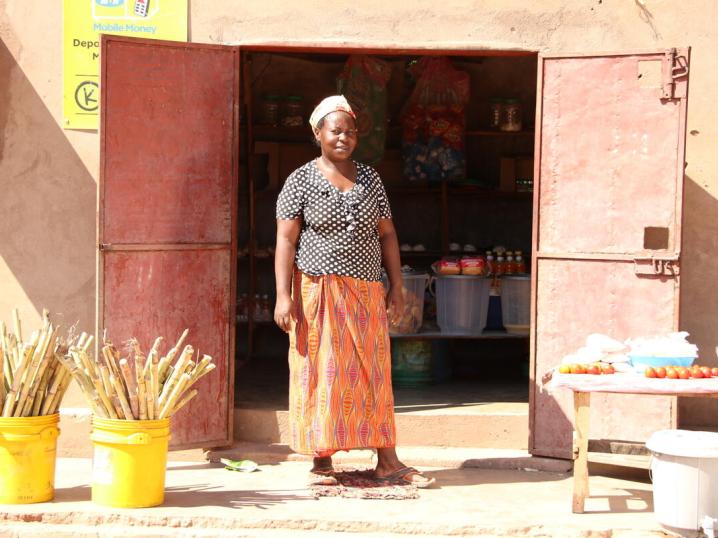Building Resiliency During a Time of Fragility

Written by Kaitlin McGarvey, North America Fundraising Manager, VisionFund International
The Gendered Impacts of COVID-19
The COVID-19 pandemic is disproportionately impacting women and girls, reversing the substantial progress that has been made in recent years to improve their lives. The UN warns, “The pandemic is deepening pre-existing inequalities, exposing vulnerabilities in social, political and economic systems,” noting that “across every sphere, from health to the economy, security to social protection, the impacts of COVID-19 are exacerbated for women and girls simply by virtue of their sex.”[1]
The economic impacts of COVID-19 are more severe (and different) for women than men. This is particularly true in the countries where VisionFund and World Vision serve; where 70% of employed women work in informal economies. Informal economies are largely dependent on public space (i.e. a market), frequent social interactions, and low wages. As a result of COVID-19 restrictions, an increase in the amount of unpaid labor shouldered by women, and a lack of sufficient savings:
It is possible to project that the impacts of the COVID-19 global recession will result in a prolonged dip in women’s incomes and labor force participation, with compounded impacts for women already living in poverty. For those who, as a result of recent economic growth managed to escape from extreme poverty, they are likely to fall back into this most vulnerable of situations once again.[2]
In response to the gendered impacts of COVID-19, António Guterres, UN Secretary General, made a plea for countries and non-governmental organizations (NGOs) alike to “put women and girls at the centre of efforts to recover from COVID-19.”[3]
VisionFund and World Vision are responding to this appeal through Recovery Loans.
Recovery Loans
COVID-19 has forced many of the vulnerable poor, particularly women, to consume their limited cash savings just to buy food and other essentials; some have even begun selling farm and business assets. It is important for VisionFund and World Vision to intervene as quickly as possible to prevent our clients from falling deeper into poverty. The World Bank estimates that between 88 and 115 million people have been pushed back into extreme poverty in 2020 alone. With the third and, for many countries, deadliest wave of COVID-19 sweeping the globe, we can expect this number to rise.
In order to help our clients build their resiliency during this period of enormous economic shock, VisionFund is providing recovery loans. Recovery loans are largely working capital loans that allow businesses to reopen or business owners to diversify their operations in order to restore their livelihoods.
Between October 2020 and March 2021, VisionFund has provided 217,674 recovery loans valued at $119,524,654 to our clients across 12 countries. Through March 2021, 79% of our recovery loan recipients are women. More broadly, VisionFund has provided over 1 million loans (76% to women) totaling $557,300,000 to support economic stability between April 2020 and April 2021.
VisionFund is seeing an impressive 97% repayment rate for recovery loans, making this an appealing product for both our clients and our microfinance institutions.
Successful and In-Demand
It’s one thing to disburse loans, but it’s another to know the magnitude of impact.
In March this year, a study on the impact of recovery loans was conducted by 60 Decibels, a specialist impact measurement organization, which involved interviews with 206 clients of VisionFund Kenya, 150 of whom were women.
The results are both exciting and humbling.
They are exciting because we know that recovery loans work. 91% of respondents said that their life was improved because of their recovery loan, with 83% of those caring for children reporting that a recovery loan improved their ability to support their children.
The results are humbling because 92% of respondents said they could not find an alternative to the recovery loan, meaning a recovery loan is their only financial lifeline during this pandemic. It’s wonderful to have a product that works; a product that helps women grow in prosperity rather than fall back into poverty; a product that allows women to reach their full potential as creative, innovative, strategic business leaders. However, if we are currently the only financial service provider for the communities we serve, we still have significant work ahead of us.
As an organization focused on serving the most vulnerable clients living in the most fragile contexts, we need to expand our recovery lending work. There are millions of prospective clients who are eligible for recovery loans and eager to return to business. Through the help of our donor partners, we can more efficiently and effectively meet this demand.
She Can Thrive
Women’s economic empowerment has always been central to gender equality. Even before the COVID-19 pandemic, women were poorer than men, which has far-reaching repercussions for society at large. However, the pandemic has further exacerbated and highlighted gender inequalities.
When women have access to financial services, they are able to improve both their and their children’s well-being. This is particularly important during a pandemic when the cost of healthcare is out of reach for many of the world’s poorest and most rural communities.
As women are able to revitalize their businesses (through the support of recovery loans), their incomes will grow. This allows them to save and invest, providing them with greater economic and physical health. A growth in income and savings can give women access to tools critical for preventing the spread of COVID-19 (i.e. masks, soap, and healthcare).
At a time when the world is experiencing unprecedented fragility, recovery loans are able to help women farmers and business owners pivot and adapt, so that they can thrive today and into the future.
[1] https://www.unwomen.org/-/media/headquarters/attachments/sections/library/publications/2020/policy-brief-the-impact-of-covid-19-on-women-en.pdf?la=en&vs=1406
[2] https://www.unwomen.org/-/media/headquarters/attachments/sections/library/publications/2020/policy-brief-the-impact-of-covid-19-on-women-en.pdf?la=en&vs=1406
[3] https://www.un.org/en/un-coronavirus-communications-team/put-women-and-girls-centre-efforts-recover-covid-19